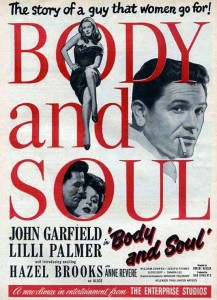That’s what the movie’s screenwriter, Abraham Polonsky, called Body and Soul.
No telling at this point whether campus will be open and we’ll have class to discuss this tomorrow. But we will talk about Body and Soul at some point. In the meantime, you may wish make comments or raise questions about the film here.
Among the interesting features of the film is the fact that, like All My Sons, the film was the product of the leftwing circles that flourished in New York’s theater and entertainment circles during the 30s and early 40s. Polonsky, a Columbia Law School grad who worked in the Office of Strategic Services (i.e., the predecessor to the CIA) during the war, was also a member of the Communist Party and would become an early target of investigators with the House Unamerican Activies Committee (HUAC) in 1951. After directing the great film noir Force of Evil (also starring John Garfield) in 1948, he was blacklisted and kept out of Hollywood work for 17 years. (Though his contribution was uncredited, he did write the screenplay for a later classic heist film, Odds Against Tomorrow (1959)–in which the rivalry between Sidney Poitier and Sterling Hayden is used to reveal the evils of American racism.)

Also blacklisted were Anna Revere, who plays Charley Davis’s mother, and John Garfield–whose life was in a number of respects like that of the man he played (tough kid from New York who grows up in a home, shows a talent for boxing and acting, and is discovered by some benevolent elders who lead him to stardom)–and a number of other performers on the film. The movie’s director, Robert Rossen–also a tough NYC kid and former boxer–was himself blacklisted, but somewhat like Elia Kazan, saved his career by recanting and naming names. He went on to direct the classic Paul Newman vehicle The Hustler, among several other less celebrated films.

So, like All My Sons, Body and Soul was the product of a flourishing political and cultural milieu that was nevertheless on the verge of being wiped out.
You might consider Polonsky’s words in that light and the image of the city the movie provides for us. What’s important about that world? What characteristics does it have? How does it compare to what we see in Miller’s play?


